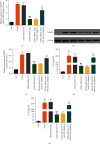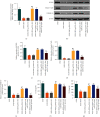HBO Alleviates Neural Stem Cell Pyroptosis via lncRNA-H19/miR-423-5p/NLRP3 Axis and Improves Neurogenesis after Oxygen Glucose Deprivation
- PMID: 35178162
- PMCID: PMC8844101
- DOI: 10.1155/2022/9030771
HBO Alleviates Neural Stem Cell Pyroptosis via lncRNA-H19/miR-423-5p/NLRP3 Axis and Improves Neurogenesis after Oxygen Glucose Deprivation
Abstract
Due to the limited neurogenesis capacity, there has been a big challenge in better recovery from neurological dysfunction caused by stroke for a long time. Neural stem cell (NSC) programmed death is one of the unfavorable factors for neural regeneration after stroke. The types of death such as apoptosis and necroptosis have been deeply investigated while the pyroptosis of NSCs is not quite understood. Although it is well accepted that hyperbaric oxygen (HBO) alleviates the oxygen-glucose deprivation (OGD) injury after stroke and reduces programmed death of NSCs, whether NSC pyroptosis is involved in this process is still unknown. Therefore, this study is aimed at studying the potential effect of HBO treatment on NSC pyroptosis following OGD exposure, as well as its influence on NSC proliferation and differentiation in vitro. The results revealed that OGD increased NOD-like receptor protein 3 (NLRP3) expression to induce the pyroptotic death of NSCs, which was rescued by HBO treatment. And the upregulated lncRNA-H19 functioned as a molecular sponge of miR-423-5p to target NLRP3 for NSC pyroptosis following OGD. Most importantly, it was confirmed that HBO exerted protection of NSCs against pyroptosis by inhibiting lncRNA-H19/miR-423-5p/NLRP3 axis. Moreover, HBO restraint of lncRNA-H19-associated pyroptosis benefited the proliferation and neuronal differentiation of NSCs. It was concluded that HBO attenuated NSC pyroptosis via lncRNA-H19/miR-423-5p/NLRP3 axis and enhanced neurogenesis following OGD. The findings provide new insight into NSC programmed death and enlighten therapeutic strategy after stroke.
Copyright © 2022 Yuqin Ye et al.
Conflict of interest statement
The authors declare that there is no conflict of interests.
Figures







Similar articles
-
Long non-coding RNA H19 contributes to spinal cord ischemia/reperfusion injury through increasing neuronal pyroptosis by miR-181a-5p/HMGB1 axis.Aging (Albany NY). 2022 Jul 5;14(13):5449-5463. doi: 10.18632/aging.204160. Epub 2022 Jul 5. Aging (Albany NY). 2022. PMID: 35793244 Free PMC article.
-
LncRNA MEG3 inhibits the proliferation of neural stem cells after ischemic stroke via the miR-493-5P/MIF axis.Biochem Biophys Res Commun. 2021 Sep 3;568:186-192. doi: 10.1016/j.bbrc.2021.06.033. Epub 2021 Jul 15. Biochem Biophys Res Commun. 2021. PMID: 34273844
-
LncRNA Tug1 Contributes Post-stroke NLRP3 Inflammasome-Dependent Pyroptosis via miR-145a-5p/Tlr4 Axis.Mol Neurobiol. 2022 Nov;59(11):6701-6712. doi: 10.1007/s12035-022-03000-4. Epub 2022 Aug 22. Mol Neurobiol. 2022. PMID: 35989413
-
New Insights into the Role of Mild Hypoxia in Regulating Neural Stem Cell Characteristics.Stem Cells Dev. 2024 Jul;33(13-14):333-342. doi: 10.1089/scd.2024.0020. Epub 2024 Jun 11. Stem Cells Dev. 2024. PMID: 38753713 Review.
-
Non-Coding RNAs in the Regulation of Hippocampal Neurogenesis and Potential Treatment Targets for Related Disorders.Biomolecules. 2022 Dec 22;13(1):18. doi: 10.3390/biom13010018. Biomolecules. 2022. PMID: 36671403 Free PMC article. Review.
Cited by
-
Electroacupuncture Alleviates Cerebral Ischemia-reperfusion Injury by Regulating the S1PR2/TLR4/NLRP3 Signaling Pathway via m6A Methylation of lncRNA H19.Curr Neurovasc Res. 2024;21(1):64-73. doi: 10.2174/0115672026294183240207115956. Curr Neurovasc Res. 2024. PMID: 38409728
-
Hyperbaric Oxygen Therapy and Tissue Regeneration: A Literature Survey.Biomedicines. 2022 Dec 6;10(12):3145. doi: 10.3390/biomedicines10123145. Biomedicines. 2022. PMID: 36551901 Free PMC article. Review.
-
Linc00205/Mir-495-3p/Tnfsf15 Axis is Implicated in the Treatment Effect of Hyperbaric Oxygen Therapy on Patients with Post-Stroke Cognitive Impairment.Noro Psikiyatr Ars. 2024 Oct 23;62(1):11-19. doi: 10.29399/npa.28530. eCollection 2025. Noro Psikiyatr Ars. 2024. PMID: 40046208 Free PMC article.
-
Mitochondrial transplantation confers protection against the effects of ischemic stroke by repressing microglial pyroptosis and promoting neurogenesis.Neural Regen Res. 2024 Jun 1;19(6):1325-1335. doi: 10.4103/1673-5374.385313. Epub 2023 Sep 22. Neural Regen Res. 2024. PMID: 37905882 Free PMC article.
-
Hyperbaric Oxygen Promotes Chronic Wound Healing in Sprague-Dawley Rats by Inhibiting Pyroptosis.Physiol Res. 2024 Dec 31;73(6):1049-1061. doi: 10.33549/physiolres.935398. Physiol Res. 2024. PMID: 39903894 Free PMC article.
References
-
- Goncalves J. T., Schafer S. T., Gage F. H. Adult neurogenesis in the hippocampus: from stem cells to behavior. Cell . 2016;167(4):897–914. - PubMed
-
- Liu Q., Li Y., Zhou L., et al. GRP78 promotes neural stem cell antiapoptosis and survival in response to oxygen-glucose deprivation (OGD)/reoxygenation through PI3K/Akt, ERK1/2, and NF-κB/p65 pathways. Oxidative Medicine and Cellular Longevity . 2018;2018:12. doi: 10.1155/2018/3541807.3541807 - DOI - PMC - PubMed
MeSH terms
Substances
LinkOut - more resources
Full Text Sources

